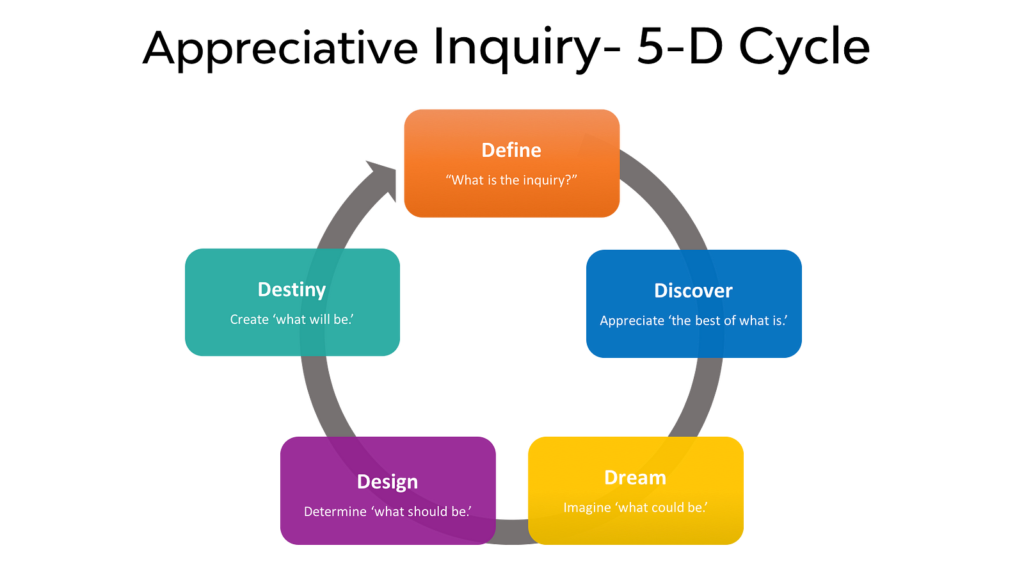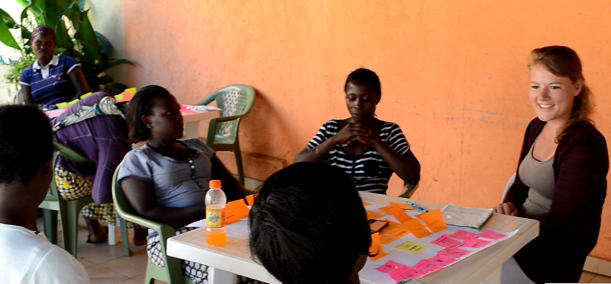Appreciative Inquiry (AI) is an approach to inquiry based on positive psychology, which aims to shift away from problem-oriented approaches towards a strength based approach: to recognize the existing good and dream about possibilities to make it even better. It helps to get to know the assets within a community: all that’s going well, what people are proud of, talents, abundances et cetera and to spark a positive, creative vibe among PAO participants. The basic idea is that starting from ‘bad’, we can fix it, resulting in ‘not bad’; starting from ‘good’, there are no boundaries in getting better. Appreciative Inquiry, like Participatory Action Research (PAR), has its origins in social constructionism. Developed by David Cooperrider in the 1980s, it was initially deployed within change management organizations. The principles and methodology are also very well applicable in PAR.
When to use
- When you feel there are many (hidden) assets in a community that are not being used
- When creativity among people is low
- When there are tensions between parties
- When people only tend to see ‘the bad side’
Advantages
- It encourages and empowers people to see opportunities within their own community and take action accordingly
- It sparks creativity among people
- Helps people to visualise a commonly shared vision
- Creates a positive vibe
- There are multiple varieties to apply
Disadvantages
- When applied wrongly, it can have adverse effects
- Requires training before use
Basic principles
- The social constructionist principle: “we do not see things as they are, we see them as we are”. There is no objective reality or truth; it is what we make of it: we construct reality.
- The poetical principle: “If you focus on problems, you find more problems. If you focus on success, you find more successes”.
- The simultaneity principle: “all questions are leading questions”: asking a question is the first step towards change. It is not about finding the right question, but finding the question that leads to the right direction.
- The anticipating principle: “If you want to build a ship, don’t drum up the people to gather wood, divide the work and give orders. Instead, teach them to yarn for the vast and endless sea.”
- The positivity principle: “when we seek to discover the best in others, we somehow bring out the best in ourselves”. Positive emotions are not just pleasant experiences; they play an important role in the wellbeing of people (Hoogendijk 2015).
As you can see, AI has many overlapping principles with PAR and is often mentioned in literature as a form of PAR. What I like most of AI is its focus on the positive. Applying AI has a huge positive effect on people’s mindset and motivation to bring positive change in their community. Through AI, people shed a different light on their problems. Rather than focusing on ‘all that is going bad’, the AI approach focuses on ‘what is going well’ and ‘what do we want more of’. Although I do feel that participants first need to get the opportunity to ‘ventilate’ there problems, worries and fears, the way of interviewing in AI helps them to also see the strengths in themselves and the community that enables them to tackle the addressed issue(s).
Appreciative Inquiry stages
Five stages (“the five Ds”) are traversed in AI:

Define: define the core theme. Together with participants, we look at what the Appreciative Inquiry process will be about. This is formulated in a neutral or positive way and is therefore also referred to as the “positive core”.
Discover: Let participants share what goes well. The success stories from the past are looked back on and based on this, the strength, the success factors and the talents of society or group are examined.
Dream: imagine the desired future. In this phase, participants look ahead: what would you like to see more in the future? Which success factors and talents (from the Discover phase) are worth pursuing for the future?
Design: At this stage participants co-create plans to achieve the desired future.
Deliver: at this stage the participants implement the co-created plans. This phase is also called Destiny.
How to use
There are two ways of applying AI in PAR.
1. Appreciative Inquiry as a PAR framework
AI could serve as a stage framework, as an alternative to PAO’s original stages framework. Just like in PAO, you choose different mixed methods within each “D” that you can find on our website, in the (Appreciative Inquiry) literature or other sectors, to go through each AI stage. The advantage is that the stages are easier to communicate to participants and that they can be more easily remembered, because all stages start with a “D”.
2. Appreciative Inquiry as a PAR method
Within your PAR framework, you can also apply AI as one of your research methods. For example, the stages mentioned under point 1 above -or a selection of those- can also be applied in a compact version during for example a focus group. During the Healthy Cooking Challenge I advised my participants to apply AI during such focus group, which turned out to have a huge positive effect on the atmosphere during the focus group as well as its outcomes. Through focusing on ‘what is going well in the community’ and ‘what are people proud of’, my Challenge participants found out that a local cinema -what people were proud of- could be used to tackle lung disease in babies and children. It was a combination of ‘problem’ and ‘solution’ that would have never been found focusing on the problem solely. This blog about the Healthy Cooking Challenge explains -amongst others- the impact of applying the principles and methodology of Appreciative Inquiry.
AI can also be applied during a one-on-one interview. The interview then gets a more semi-structured approach, in which you have the list of topics -the AI phases- in your head and maybe some questions too, but the rest of the questions are built upon the participants’ answers. Below I have listed some example questions which you can use in each AI phase. You can use these questions in one-on-one interviews as well as in group-interviews. Just adapt them where necessary to fit the research method. The book ‘Appreciative Teambuilding. Positive Questions to Bring Out the Best of Your Team’ (Whitney et al 2004) is full of these types of questions. As the title suggests, it is written for teambuilding within organizations, but can easily be adapted to community settings.
Define
- What situation would you like to change?
Discover
- Can you think of a situation where you have overcome a challenge -small or big and you were proud of the outcome?
- What are you proud of in this community?
- Can you think of a situation where you worked together with other people to overcome a challenge, which you really enjoyed?
Dream
- How does situation [x] ideally look like to you?
- How would your life look like if you have reached that ideal situation?
Design
- What strengths, talents and opportunities in this community can we use to reach the DREAM?
- What activities do you think are going to help reach the DREAM?
- Under what conditions would you be happy to contribute to reach the DREAM?
- How can other people help you reach the DREAM?
- How can you help other people to reach the DREAM?
Destiny
- Can you describe one or more situations during the execution of the action plan that made you happy or proud?
- How could you include or translate those situations into the implementation of the following actions?
- What would you like more in the implementation of the following actions from the plan?
- Can you describe a situation in which you or the team you worked with recovered quickly or easily after a setback? (Who were involved, which factors contributed to rapid recovery, et cetera.)
Literature
Hoogendijk, C. (2015). Appreciative Inquiries of the 3.0 kind. How do we connect, share and co-create for tomorrow’s human wholeness? Society 3.0 Foundation.
Whitney, D., Trosten-Bloom, A., Cherney, J. and Fry, R. (2004). Appreciative Teambuilding. Positive questions to bring out the best of your team. iUniverse, Inc., USA.

